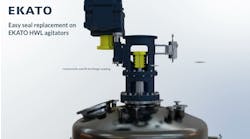A risk assessment today, regardless of the particular technique used, often has a dual focus — safety, of course, but also cost effectiveness. Financially astute managers want to ensure the risk assessment process produces the "best" results in as short a time as possible with as small an impact on the project schedule as practicable.
Unfortunately, seemingly minor issues such as poor lighting and frequent disruptions can derail the risk assessment process. Not having the right mix of people on the team can undermine efforts. Many other issues also can compromise the effectiveness and efficiency of an assessment.
So, let's look at some elements of a well-planned strategy.
IMPORTANT PRELIMINARIES
Prior to the start of the risk assessment process, get a good understanding of the project scope and project specifics. While this may seem obvious, it's all too easy to miss. The following hypothetical examples help demonstrate the point:
At the time of a hazard and operability (HAZOP) review, the facilitator learned for the first time that five companies were involved in the project and that each company had different sets of HAZOP procedures, risk rank criteria, and data management systems. As might be surmised, this caused a considerable uproar. Unfortunately, the project was on a tight schedule. So, the facilitator called a short time-out and quickly assembled "key players" to work out a consensus.
Another facilitator relied on a software program that also was used by the client company. However, the facilitator had a later version than the client. The client's earlier version couldn't open the risk assessment files developed by the facilitator. Eventually, after a considerable effort, the files were made compatible with the client's system.
Take heed of the following pointers:
• When conducting an assessment at a new site, ensure that proper functional testing has been performed on support systems (e.g., lighting, projector, network and internet connections).
• Understand technology and jargon specific to the project or plant to be assessed. Focus on the potential impact of the technology on safety issues.
• Carefully define the scope of work and communicate it in advance to all concerned.
• Engage early on with the manager or project manager. Learn that person's viewpoints and time constraints. Take the opportunity to emphasize that a hastily performed risk assessment undermines the goal of ensuring a desired level of safety. Spend some time briefly going over relevant safety incidents or investigations to help shape the manager's perception about safety. That person's "buy-in" on the assessment can provide an added impetus to the team.
• People with little or no experience in a given area sometimes tend to assume risks are lower than their experienced counterparts believe. So, insist on having seasoned people (e.g., operators, instrument engineers, design and structural engineers, etc.) on the team.
• Multiparty projects may result in large risk assessment teams. Attempt to optimize the team size, if possible; usually it's best to have no more than six to eight people. (This may not be possible if project sponsors insist on having many participants from their organization).
• Remember the goal is to use the team's expertise to assess risk. Establish a good rapport with the team. Understand and respect cultural differences. Think about sharing mini-safety pointers to help shape team members' perceptions about safety.
• For multiparty projects, resolve the key issues of risk assessment methodology in advance. In these situations, team members from different companies likely will have divergent views. In some cases, they could have vastly differing viewpoints on safety. Getting a consensus early — before the start of the assessment session — helps streamline the process.
• Review a company's risk assessment process, database management systems and software (including version number). If you'll be using an in-house risk matrix, ensure it's the most recent version.
DURING THE ASSESSMENT
The chief goal is to identify as many risks as possible within the allocated time. Some participants on the team may have strong opinions about safety while others may be indifferent to the entire risk-assessment process. The facilitator has a multifaceted task of being a coach, a motivator and an enforcer, at the same time.
To improve the assessment session:
• Ensure that projected images of documents (e.g., process and instrumentation diagrams, design drawings, assessment worksheets and other relevant information) are easy for everyone to read.
• Take a strategic approach to allocating time. Allow sufficient time to discuss scenarios that involve relatively high risk; don't dwell on minor or manageable risks.
• Avoid hastily modifying the risk value. In some situations when a risk matrix indicates a risk is high, the team may try to keep adjusting the risk value and eventually force it to a lower value. Although there's nothing wrong with questioning the value arrived at by the risk matrix, don't hastily modify it just to make the team feel comfortable at that moment.
• Keep layer-of-protection-analysis (LOPA) assessments from turning into number-crunching exercises. At the outset, help the team understand the attributes of independent protection layers.
• Guard against a HAZOP review focusing almost exclusively on hazards. It also should include operability assessment. The goal is to ensure the plant not only is safe but also reliable, e.g., free from spurious trips.
• Check if the project involves adoption of new technology because such technology may pose unique hazards. For instance, instrument technicians may not be familiar with how to properly install and maintain a novel sensor — and this could impact safety. If such technology is being considered, then systems should be set up for appropriate training and testing of all persons involved.
POST ASSESSMENT
Astute managers want to address risk assessment findings as soon as practical. OSHA 29 CFR 1910.119 (e) (5) also indicates there should be a mechanism to address the findings "promptly." So:
• Develop a list of recommendations from the risk assessment and forward them right away to appropriate personnel so that corrective action can be initiated in a reasonable time.
• When writing the report on the assessment, focus on risk minimization and regulatory compliance — and keep the report as concise as possible. Also, remember that a diverse group of people, probably including some unfamiliar with risk assessment, will review the report; so make it easy to understand. Use active, not passive, style.
• Streamline the record-keeping process. The documentation system should efficiently communicate to appropriate personnel the status of corrective actions — including any necessary periodic testing to verify the new equipment and controls will function safely and productively. Avoid bureaucratic systems — someone shouldn't have to complete a form and get multiple levels of approval to check HAZOP status.
• Think of risk assessment not as a one-time activity but as an ongoing process. So, ensure that the organization has an effective safety-management system in place to sustain safety on a continuing basis.
BE EFFECTIVE AND EFFICIENT
A risk assessment professional should take today's intense pressure to shorten project schedules into consideration. On the other hand, it's also crucially important to recognize that risk assessment, by definition, requires a thoughtful approach. The challenge is to achieve a proper balance of the competing goals of ensuring safety and efficiency.
G. C. SHAH, PE, CFSE, CSP, CIH, CFPS, CAP, CQE, is a safety, environmental and industrial hygiene professional at Wood Group Mustang Inc., Houston. E-mail him at [email protected].


